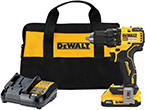Have you ever been faced with the problem of trying to repair something, and when you go to screw or unscrew a screw find out that you can't? Looking closely when this happens, chances are you are going to notice that the screw is stripped. Man I hate when this happens! It means that the screwdriver I am using is not going to work at all, no matter what I do.
At least, that is what it used to mean, since with this handy dandy how-to list I, and now you, can replace that dang screw.
Materials Needed
Once you have collected all of these materials, you are ready to begin. The first thing that you need to do is that you apply a Philips screwdriver that is larger in size than what is usually used. (This assumes that the screw is a Philips head.) Push down really hard, using a slight angle, and try to slowly remove the screw. In the event that the stripping worsens, you need to stop immediately.
If that doesn't work, then you can try removing the screw with a large flathead screwdriver. If the slits are centered on the stripped head, then use the largest flathead screwdriver that is going to fit the slot. Using pressure on the screw, try to turn the screw counter-clockwise. This might be able to get the screw out.
You can, if necessary, use the Dremel tool or the metal saw to create a slit in the in the screw. When you are doing this you pretty much want to make sure that you wear the safety glasses so that you do not get any metal slivers or dust thrown into your eyes. After you have created that notch into the screw, then try using the flat-blade screwdriver to get the screw out.
Next, use your drill to create a hole that is smaller than the head of the screw. This hole should be approximately 1/3 the size of the head and extend into the screw itself about 1/4 of an inch. Insert a very small Philips screwdriver into the hole and attempt to remove the screw.
A handy tool to have in these situations is a screw extractor or a left-handed drill bit. You need to push down on the stripped screw head and slowly try to remove the screw. Be sure that you are careful not to push too hard, or the screw may break.
If any of the foregoing methods fail, then as a last resort you can always drill the screw out. In order to do this you just need to have a drill bit that is either the same size or slightly smaller than the shank of the screw. If you don't know the size of the screw, simply take another one of the screws and compare it to a drill bit in order to find the proper fit.

Cordless, Compact, and Powerful! DeWalt's 20-volt drill-driver kit packs a big punch in a small package, with a powerful high-performance motor tucked away inside a compact design. A great addition to the tool chest of any professional or DIYer! Check out DeWalt 20-Volt Drill/Driver Kit today!
Whether you are hanging a family heirloom, building furniture or working on your "honey do" list, it is important to know ...
Discover MoreWhen it comes time to begin trimming, cutting back, or otherwise pruning your bushes and hedges, then a garden hedge ...
Discover MoreHave you ever tried to remove a screw, only to find it being particularly stubborn or difficult? Removing stubborn screws ...
Discover MoreThere are currently no comments for this tip. (Be the first to leave your comment—just use the simple form above!)
Copyright © 2025 Sharon Parq Associates, Inc.
Comments